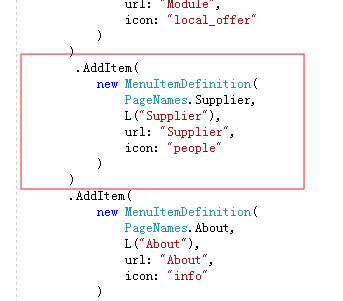abp(net core)+easyui+efcore实现仓储管理系统目录
abp(net core)+easyui+efcore实现仓储管理系统——ABP总体介绍(一)
abp(net core)+easyui+efcore实现仓储管理系统——解决方案介绍(二)
abp(net core)+easyui+efcore实现仓储管理系统——领域层创建实体(三)
abp(net core)+easyui+efcore实现仓储管理系统——定义仓储并实现 (四)
abp(net core)+easyui+efcore实现仓储管理系统——创建应用服务(五)
abp(net core)+easyui+efcore实现仓储管理系统——展现层实现增删改查之控制器(六)
abp(net core)+easyui+efcore实现仓储管理系统——展现层实现增删改查之列表视图(七)
abp(net core)+easyui+efcore实现仓储管理系统——展现层实现增删改查之增删改视图(八)
abp(net core)+easyui+efcore实现仓储管理系统——展现层实现增删改查之菜单与测试(九)
abp(net core)+easyui+efcore实现仓储管理系统——多语言(十)
abp(net core)+easyui+efcore实现仓储管理系统——使用 WEBAPI实现CURD (十一)
abp(net core)+easyui+efcore实现仓储管理系统——使用 WEBAPI实现CURD (十二)
上接(abp(net core)+easyui+efcore实现仓储管理系统——使用 WEBAPI实现CURD (十二)),在这一篇文章中我们创建视图模型、列表视图、添加菜单。
六、创建视图模型
1) 在Visual Studio 2017的“解决方案资源管理器”中,右键单击在领域层“ABP.TPLMS.Web.Mvc”项目中的Models目录。 选择“添加” > “新建文件夹”。并将文件夹命名为“Supplier”。
2) 鼠标右键单击“Supplier”文件夹,然后选择“添加” > “类”。 将类命名为 EditSupplierModalViewModel,代码如下。
using System.Collections.Generic; using System.Linq; using ABP.TPLMS.Modules.Dto; namespace ABP.TPLMS.Web.Models. Supplier { public class EditSupplierModalViewModel { public CreateUpdateSupplierDto Supplier { get; set; } } }
3) 鼠标右键单击“Supplier”文件夹,然后选择“添加” > “类”。 将类命名为 SupplierListViewModel,代码如下。
using System.Collections.Generic; using ABP.TPLMS.Suppliers.Dto; namespace ABP.TPLMS.Web.Models.Supplier { public class SupplierListViewModel { public SupplierDto Supplier { get; set; } public IReadOnlyListSuppliers { get; set; } } }
七、创建列表视图
我们参考“ABP.TPLMS.Web.Mvc”项目中的Views\Users目录中的Index.cshtml文件,来编写我们的Supplier的列表页面。
1. 在Visual Studio 2017的“解决方案资源管理器”中,右键单击在展现层“ABP.TPLMS.Web.Mvc”项目中的Views目录。 选择“添加” > “新建文件夹”。并重命名为“Supplier”。
2. 在Visual Studio 2017的“解决方案资源管理器”中,鼠标右键单击“Supplier”文件夹,然后选择“添加” > “新建项…”。 在“添加新项-ABP.TPLMS.Web.Mvc”对话框中,选择“Razor视图”,并将名称命名为Index.cshmtl。
3. 在Index视图中,我们通过循环遍历,输出模块信息。代码如下。
@using ABP.TPLMS.Web.Startup @model ABP.TPLMS.Web.Models.Supplier.SupplierListViewModel @{ ViewData["Title"] = PageNames.Supplier; } <div class="row clearfix"> <div class="col-lg-12 col-md-12 col-sm-12 col-xs-12"> <div class="card"> <div class="header"> <h2> @L("Supplier") h2> <button type="button" class="btn btn-primary btn-circle waves-effect waves-circle waves-float pull-right" data-toggle="modal"
data-target="#SupplierCreateModal"> <i class="material-icons">addi> button> <ul class="header-dropdown m-r--5"> <li class="dropdown"> <a href="javascript:void(0);" class="dropdown-toggle" data-toggle="dropdown" role="button" aria-haspopup="true"
aria-expanded="false"> <i class="material-icons">more_verti> a> <ul class="dropdown-menu pull-right"> <li><a id="RefreshButton" href="javascript:void(0);" class="waves-effect waves-block">
<i class="material-icons">refreshi>@L("Refresh")a>li> ul> li> ul> div> <div class="body table-responsive"> <table class="table"> <thead> <tr> <th> @Html.DisplayNameFor(model => model.Supplier.Code) th> <th> @Html.DisplayNameFor(model => model.Supplier.Name) th> <th> @Html.DisplayNameFor(model => model.Supplier.LinkName) th> <th> @Html.DisplayNameFor(model => model.Supplier.Mobile) th> <th> @Html.DisplayNameFor(model => model.Supplier.Address) th> <th> @Html.DisplayNameFor(model => model.Supplier.Tel) th> <th> @Html.DisplayNameFor(model => model.Supplier.Status) th> <th>th> tr> thead> <tbody> @foreach (var item in Model.Suppliers) { <tr> <td> @Html.DisplayFor(modelItem => item.Code) td> <td> @Html.DisplayFor(modelItem => item.Name) td> <td> @Html.DisplayFor(modelItem => item.LinkName) td> <td> @Html.DisplayFor(modelItem => item.Mobile) td> <td> @Html.DisplayFor(modelItem => item.Address) td> <td> @Html.DisplayFor(modelItem => item.Tel) td> <td> @Html.DisplayFor(modelItem => item.Status) td> <td class="dropdown"> <a href="#" class="dropdown-toggle" data-toggle="dropdown" role="button" aria-haspopup="true" aria-expanded="false"> <i class="material-icons">menui> a> <ul class="dropdown-menu pull-right"> <li><a href="#" class="waves-effect waves-block edit-supplier" data-supplier-id="@item.Id" data-toggle="modal"
data-target="#SupplierEditModal"><i class="material-icons">editi>@L("Edit")a>li> <li><a href="#" class="waves-effect waves-block delete-supplier" data-supplier-id="@item.Id" data-module-name="@item.Name">
<i class="material-icons">delete_sweepi>@L("Delete")a>li> ul> td> tr> } tbody> table> div> div> div> div>
八、添加菜单
1. 在Visual Studio 2017的“解决方案资源管理器”中,打开单击在展示层“ABP.TPLMS.Web.Mvc”项目中的Startup目录。 找到TPLMSNavigationProvider.cs文件。如下图。
2. 在Visual Studio 2017的“解决方案资源管理器”中,打开TPLMSNavigationProvider.cs文件,此文件就是ABP系统的菜单文件,我们进行如下修改,添加一个新的菜单Supplier。如下图。
.AddItem( new MenuItemDefinition( PageNames.Supplier, L("Supplier"), url: "Supplier", icon: "people" ) )
3.在Visual Studio 2017中按F5运行应用程序。登录之后,点击“Supplier”目录,我们可以看到供应商列表页面。如下图。


